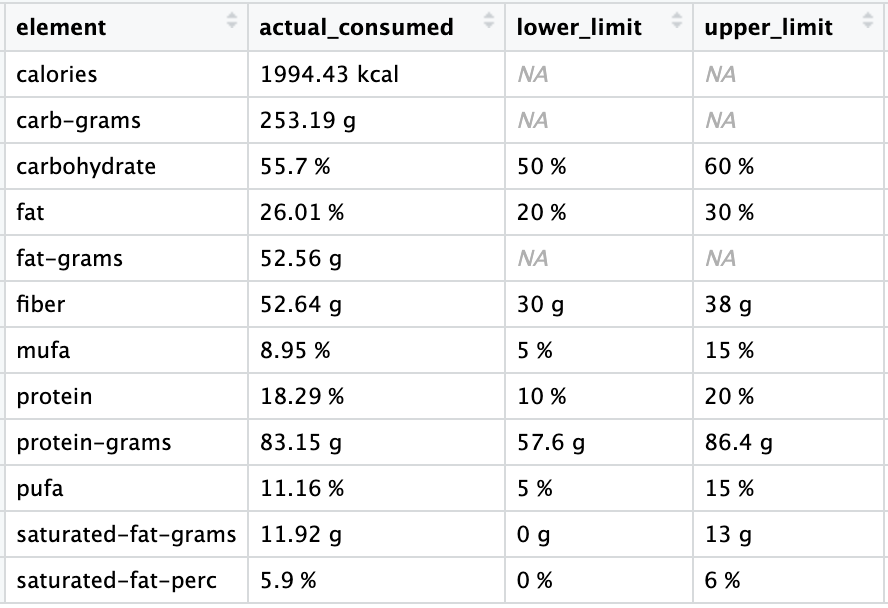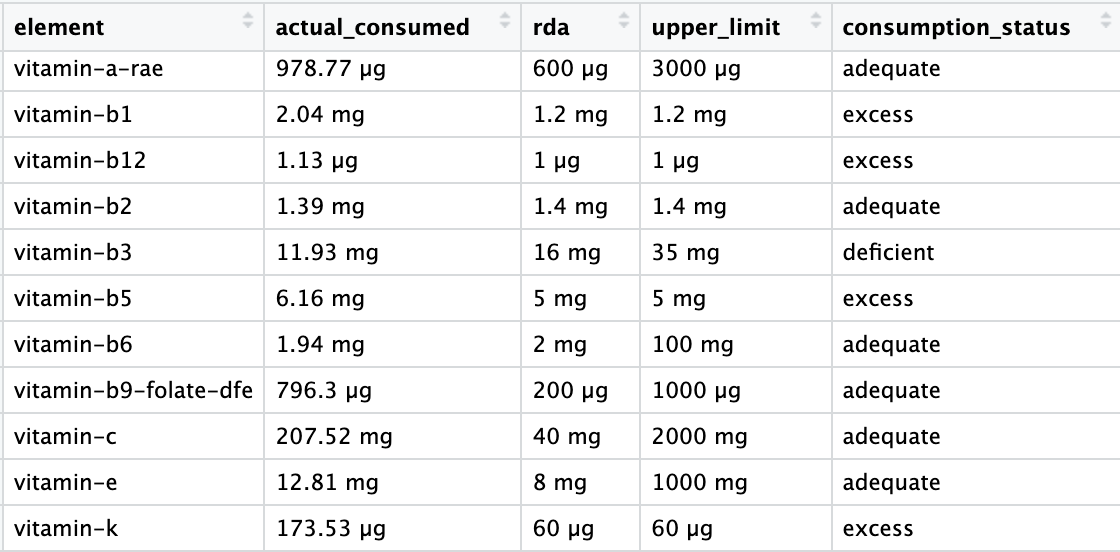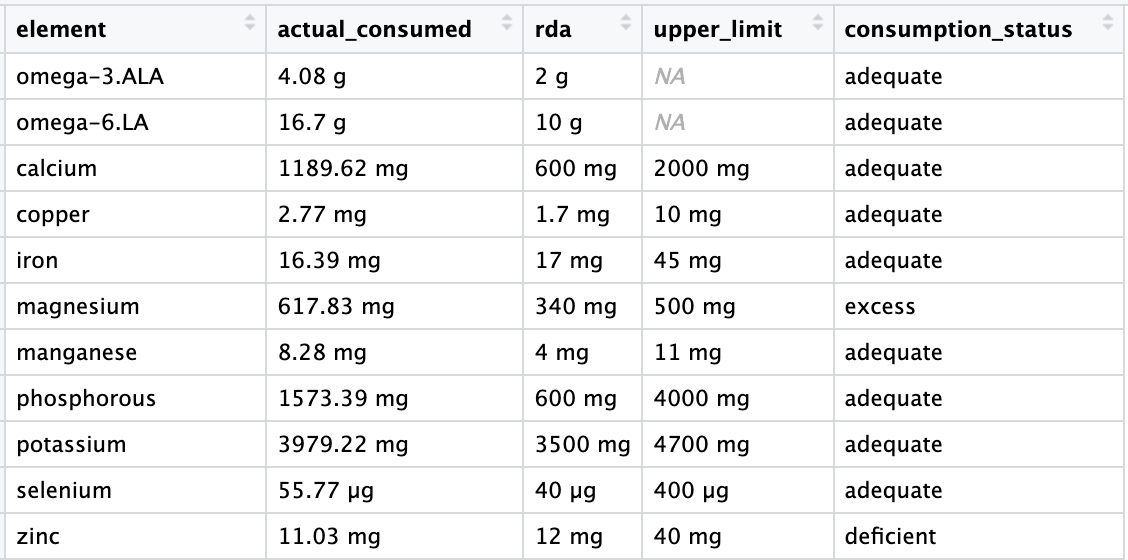How I decide what to eat
Insights into the daily decision-making behind my Indian vegetarian meals
Published: Jul 1, 2024
Reading time: 15m
Heads up!
This article is a bit long. I will simplify this some time later. But if you’re interested in understanding basics of nutrition and don’t mind a bit of an information dump, read on!
Background
I developed an interest in understanding nutrition and learning how diet affects our body a few years ago. I read a few books, lots of articles, understood what my body needs, what is good and bad for my body, how to read nutrition labels, etc. and distilled all of that information into simple thumb rules that I can use on a daily basis to eat holistic and stay healthy.
This article gives you a brief overview of basics of nutrition and explains the analysis done by me, leaving you with a simple framework that you can use to plan your meals daily.
Note: Since I’m a vegetarian, all of my analysis was done only on plant and dairy based food and my suggestions best apply for vegans and vegetarians. I have used nutritional content data from USFDA (US Food and Drug Administration) available here and RDA (Recommended Dietary Allowances) guidelines from a mix of ICMR (Indian Council of Medical Research) data available here and here.
Understanding basics of nutrition
Nutrients required for your body are broadly classified into 2 types - Macro-nutrients (required in large amounts in the diet) and Micro-nutrients (required in trace amounts)
Macro-nutrients
Carbohydrates - 50-60% of daily calories in an Indian diet will typically come from carbohydrates. There are 3 types of carbohydrates:
— Simple Sugars - Glucose, Fructose, Galactose, etc. These are the sugars that are present in any sweet food you eat. Consumption in refined form of simple sugars (plain sugar, cold drinks, biscuits, etc.) should be limited to 20-25 grams in a single. Too much of these sugars in a single serving can cause spikes in blood glucose level.
— Starch - This is a complex carbohydrate, which means, our body has to put in more effort to break this down in order to provide energy for our cells. This is present in grains, legumes, fruits and vegetables. Complex carbohydrates do not cause drastic spikes in sugar levels unlike simple sugars.
— Fiber - Dietary fiber, also known as roughage or bulk, includes the parts of plant foods your body can’t digest or absorb. Unlike other food components, such as fats, proteins or carbohydrates — which your body breaks down and absorbs — fiber isn’t digested by your body. It is found mainly in fruits, vegetables, whole grains and legumes.
Protein - Protein should make up at least 20% of our diet. Standard thumb rules require an average person to have 0.8 to 1.2g of protein per kg of body weight. There are two broad categories of proteins:
— Essential amino acids - These aren’t produced by our body and need to be consumed through our diet. There are 9 of them.
— Non-essential amino acids - These are produced by our body and don’t need to be consumed through our diet. There are 11 of them.
Fats - 20-30% of daily calories typically comes from fat. There are 3 types:
— Saturated fat - This is primarily present in meat and dairy based products. Plant foods like groundnuts and coconut oil are also high in saturated fats. AHA (American Heart Association) suggests restricting intake of this fat to about 10g in a day.
— Trans fat - These are the worst kind of fats and should be avoided at all costs. These are present in deep-fried foods, re-used oils, etc.
— Poly-unsaturated fat - This and the mono unsaturated fat are considered to be healthy fats. There are two types of poly unsaturated fat - Omega-3 and Omega-6 which are considered essential fatty acids. Omega-3 is present in flax seeds, walnuts, chia seeds, etc. Omega-6 is present in sunflower seeds, sesame seeds, etc.
— Mono-unsaturated fat - Also called omega-9 fatty acids. It can help lower LDL (bad) cholesterol level and is good for the heart.
Micro-nutrients
This includes vitamins and minerals. There are 13 vitamins and 16 minerals that are essential for our body. These are required in trace amounts and are present in almost all foods. Some of them are present in high amounts in specific foods.
Vitamins - These are broadly classified into 2 types - Fat soluble and Water soluble. Fat soluble vitamins are stored in the liver and fatty tissues of the body and our body can use them whenever required. Water-soluble vitamins are not stored in the body and are excreted through urine. These need to be consumed daily.
— Fat soluble vitamins - vitamin A, D, E, K.
— Water soluble vitamins - vitamin B1, B2, B3, B5, B6, B7, B9, B12, C
Minerals - These are broadly classified into 2 types - Macro minerals and Trace minerals. Macro minerals are required in large amounts while trace minerals are required in trace amounts.
— Macro minerals - Calcium, Phosphorous, Magnesium, Potassium, Sodium, Chloride, Sulfur
— Trace minerals - Iron, Zinc, Iodine, Selenium, Copper, Manganese, Fluoride, Chromium, Molybdenum, etc.
Others
Other than the above, there are some other elements present in the diet:
Cholesterol - Present only in dairy and meat based products. Our body doesn’t need any additional cholesterol as it can produce it on its own. AHA suggests limiting cholesterol intake to 300 mg in a day for regular people and 200 mg in a day for people at risk of heart diseases.
Antioxidants - These are present in fruits and vegetables and are good for our body. They help in reducing oxidative stress in our body. Bright-colored fruits and vegetables are generally high in antioxidants. Carotenoids in plants are good sources of anti-oxidants. Berries are known to have high amounts of anti-oxidants.
Choline - This is neither a vitamin nor a mineral. This is required for the synthesis of neurotransmitters and is present in high amounts in eggs, liver, etc. Our body can produce this on its own, but it’s good to have it in our diet. There are also some plant based sources of choline.
Sulforaphane - Sulforaphane is a natural plant compound found in many cruciferous vegetables like broccoli, cabbage, cauliflower, and kale. It has been linked to health benefits, such as improved heart health and digestion.
Books I’ve read
Amongst the books I’ve read, I found “How not to die” by Dr. Michael Greger to be most useful. While it explained the importance of above-mentioned nutrients, it also gave a simple framework to plan meals daily. This framework is called “Daily Dozen” and it includes 12 things that you should eat daily. You can look it up here. I liked this book as it suggested things which were pretty close to the Indian vegetarian diet I was used to, with some minor tweaks.
While it offered a basic framework, it still left a lot of choices open. For example, the daily dozen says, eat 3 servings of medium-sized fruits daily. But how do I pick which fruits to eat? Can I eat the same fruits daily? Is that okay? This is what led me to do my own analysis.
Approach
First, I wrote down the RDA requirements for me. Second, I took USFDA data and started finding top sources for each of the nutrients and got a mental model of where to find which nutrients, which nutrients are clustered in the same source, etc. I had some interesting findings which then helped me craft a variation of the daily dozen that I could use to plan my meals daily.
The R scripts used for this analysis are present in https://github.com/rsubramanyam2994/food-project.
Findings
Some nutrients are problems of plenty
- Processed foods contain too much sugar and salt that it was very easy to exceed the daily limits. For example, 3 Oreo biscuits have about 14 grams of sugar while 200 mL of Pepsi contains 22 grams of sugar. (daily recommended limit is 20-25 grams)
- AHA recommends about 6 grams of salt in a day while typical daily consumption is at least twice of that. Refer here for more details.
- All dairy based products like butter, ghee, etc. are high in saturated fat and cholesterol. 100g of butter has about 50g of saturated fat where the daily recommendation AHA suggests limiting saturated fat intake to 10g in a day. Apart from that, milk and curd (which is a staple for Indian households) also contain saturated fat but not as much as butter.
Some nutrients are present only in very limited number of foods
After this analysis, I understood why supplements are mostly for vitamin D, B12, Omega 3, Iron, Zinc, Calcium, etc. and not for things like Potassium, Magnesium, etc.
Vitamins
Vitamin A - Carrot, sweet potato, pumpkins are vegetables rich in vitamin A. 100g of carrot has about 835mcg of vitamin A where the daily RDA recommended by ICMR is 800mcg.
Vitamin E - Present mostly in nuts (almonds and sunflower seeds especially), often fortified with oils. 10 grams of sunflower seeds + 15 grams of almonds will provide 7 mg of vitamin-e where daily RDA recommended by ICMR is 8 mg. Rest 1 mg can be got from other foods.
Vitamin K - RDA varies across countries. Thumb rule is 1 mcg per kg of body weight. 100g of any green leafy vegetable like spinach, amaranth has about 400mcg of vitamin-k while cruciferous vegetables like cabbage, broccoli, etc. has 100mcg per 100g.
Vitamin C - Contrary to popular belief, orange is not the most vitamin-c rich fruit. 90 mg is the required amount per day. 100g guava contains 228 mg, 100g kiwi has 161 mg, 100g orange has only 40 mg.
Vitamin D & B12 - While Vitamin-B12 is present in dairy, vitamin-d is synthesized by our body. All Indians are very susceptible to being deficient in vitamin-d and all vegetarians will very likely be deficient in vitamin-b12. Hence, supplements are typically recommended for these.
Minerals
Calcium - Very easy to get this if you’re having a lot of dairy products, but dairy also contains a lot of cholesterol and saturated fat. 100gm of yoghurt has about 110mg calcium while 100ml of milk has about 120 mg of calcium. If you’re vegan, you will have to look for other sources. Tofu, lentils, cruciferous and green leafy vegetables contain reasonably high amounts of calcium. Fortified plant based milk is also a great source of Calcium. Two vegan super foods for Calcium are Ragi (finger millet) and green gram. 100gm of Ragi gives close to 30% of daily calcium while 80 grams of green gram has about 10% of daily required calcium.
Iron - Iron is present in higher amounts in legumes and moderate amounts in cruciferous and dark leafy vegetables, and in some grains like wheat, oats, quinoa. Like Calcium, Ragi and green gram are super foods for Iron too. 100 gm of Ragi gives 3.5 mg of iron which is about 25% of daily requirement while 80 gm of green gram gives about 33% of daily requirement.
Zinc - Zinc is present in high amounts in legumes, some grains like oats and moderate amounts in many fruits, vegetables and nuts. There is no one specific food that has very high amount of Zinc. It is present in trace amounts in a bunch of foods.
Fatty acids
- Omega 3 - Omega-3 fatty acids is present only in very few foods. 10g of flax seeds has 2.2 mg of Omega-3 ALA where we need only 2 mg daily, so that one food item will suffice. Apart from flax seeds, walnuts, chia seeds, etc. are also good sources of Omega-3.
Some nutrients are available in most foods
All other B vitamins (B1, B2, B3, B5, B6, B7, B9), macro-minerals(potassium, phosphorous, magnesium) & micro-minerals (iodine, copper, manganese, etc.) are present in most foods in small quantities.
Let’s build a meal plan!
I know that is a lot of information. I shall start simplifying it now. Let us build a meal plan keeping the scarcely available micro nutrients in mind and then extend it to other micro nutrients and macro nutrients.
- 100 gm of carrot (for vitamin-a)
- 10 gm of sunflower seeds + 15 gm of almonds + 10 gm of walnut + 10 gm of flax seeds + 10 gm of pistachios + a dash of peanut butter (for vitamin-e, omega-3, other healthy fats and about 10gm of protein) (I call this my special seeds and nuts mix)
- 100 gm of broccoli (for vitamin-k and Sulforaphane)
- 50 grams of green gram or some other pulse (for iron, calcium and ~10 grams of protein)
- 50 grams of Ragi in any form (for calcium and iron)
- 50 grams of oats in any form (for iron and zinc) (I typically have this in the form of muesli with plant based fortified milk)
- 40 grams of blueberries (for anti-oxidants)
- Supplement for vitamin-d and B12 - The supplement I eat (Remylin D) also contains B6, B9 and ALA (omega 3 fatty acid which I’m already getting via flax seeds). Please refer to your doctor before taking any supplements.
Above should take care of all the scarce micro-nutrients. Regarding macro-nutrients, carbohydrates and fat requirement will mostly be covered with above. Protein is something that might still be deficient. To solve for protein, I do the following:
- 100 grams of high protein low fat yoghurt (for about 10 grams of protein)
- 50 more grams of pulses (for about 10 grams of protein)
- 100 mL of cow milk and 200 grams of curd (for about 10 grams of protein). If you’re a vegan, you can replace this with plant based milk and curd.
This is the final meal plan. On running my analysis on this meal plan, here are the results.
Here is the macros summary. As you can see, I was able to meet all of them.

Here is the micros summary. I met the RDA of all minerals except Iron and Zinc which was borderline. WRT vitamins, except vitamin b3, I met all of them. I am not taking supplements for b3, Iron, Zinc as my annual blood reports have overall been fine so far and my physician has not recommended any supplements. (Note: The consumption_status column has a 5% buffer)
| Vitamins | Minerals |
|---|---|
 |  |
Thumb rules
While above is an example of one meal plan, it is difficult for me to curate such meal plans on a daily basis. Hence, like daily dozen, I’ve come up with my own sets of rules which is slightly more specific than what daily dozen suggests. It is difficult to follow all of these on a daily basis, so I try to do my best on a weekly basis.
- Fruits - Have a vitamin-c rich fruit 3-4 times a week (kiwi, guava), Have 1-2 other fruits of your liking 5 times a week.
- Vegetables - Have a vitamin-a vegetable 3-4 times a week (carrot, sweet potato, pumpkin), Have green leafy vegetables 3 times a week, Have cruciferous vegetables 3 times a week, Have 1 other vegetable of your liking apart from ^ 5 times a week
- Pulses - Have two 50 gram servings of different pulses 5 times a week
- Nuts and seeds - Have a mix of sunflower seeds (10 grams), almonds (15 grams), walnuts, flax seeds, pistachios, peanut butter 5 times a week
- Supplements - Have a supplement for vitamin-d and b12 daily, Have protein supplements on a need basis after calculating your protein requirement depending on your level of physical activity
- Whole grains - Have a serving of oats based muesli with plant based fortified milk 3 times a week, Ensure that grains you eat are mostly whole grains
- Berries - Have 30-40 grams of berries 3-4 times a week
- Have about 100 mL of cow milk and 200 grams of curd daily. If you’re a vegan, you can replace this with plant based milk and curd.
I have been using a habit tracker app with the above set as weekly habits to make sure I eat holistic on a weekly basis. On a daily basis, I try to tick as many boxes when planning my meals.
Conclusion
I have come up with my own habits to follow when planning meals. While it might sound complicated, it is not. It is just a matter of getting used to it. Also, with the open source information available, the data guy in me couldn’t resist not doing this analysis and find out what is good for my body and how I can plan my meals better.
Obviously I want to build an app for this too 😅 For now, I’m following these thumb rules using a simple habit tracking app.
Thank you for making it this far :) I hope you found this article useful in some way or the other.
References
- Recent publication of guidelines by ICMR - https://main.icmr.nic.in/sites/default/files/upload_documents/DGI_07th_May_2024_fin.pdf
